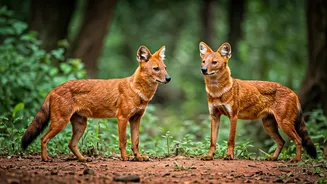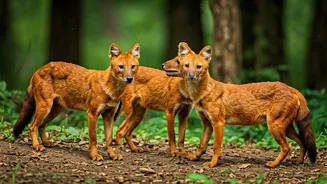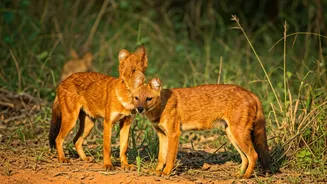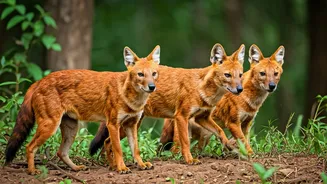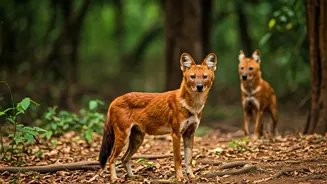Introduction to Dholes
The wild dog, scientifically known as Cuon alpinus, or dhole, presents a captivating subject for wildlife admirers, and understanding their habitat is
crucial. These social canids, native to Central, South, and Southeast Asia, lead a nomadic existence in groups. Their presence serves as a crucial indicator of the ecosystem's health, thereby emphasizing the urgent need for focused preservation efforts. The dhole's distinctive appearance, marked by a reddish-brown coat and bushy tail, sets them apart. Their adaptable nature allows them to thrive in diverse environments, from the dense forests of the Western Ghats to the mountainous regions of the Himalayas. Dholes often hunt cooperatively, using their unique strategies to take down prey much larger than themselves. Their survival is threatened due to habitat loss, prey scarcity, and conflict with humans, rendering them an endangered species. Dedicated conservation projects are therefore fundamental in ensuring that these captivating creatures endure, securing their vital position in India's biodiversity.
Bandhavgarh National Park
Bandhavgarh National Park, situated in Madhya Pradesh, is a notable sanctuary recognized for its high density of tigers and diverse wildlife, including dholes. The park’s diverse terrain, encompassing grassy meadows and dense forests, provides an ideal habitat for these wild dogs. Bandhavgarh is historically significant, with ancient caves and rock shelters showcasing the region's rich cultural heritage. Its strategic positioning, which connects several forest areas, adds to its ecological significance. Visitors to Bandhavgarh have an excellent chance of spotting dholes while enjoying various safari options, including jeep safaris and elephant rides. Conservation initiatives in the area focus on reducing human-wildlife conflict and protecting the habitat, guaranteeing the long-term survival of the dholes and other wildlife species. The park authority focuses on maintaining its natural resources by combining research, community engagement, and strict enforcement of conservation regulations. This integrated strategy has been instrumental in the steady growth of the dhole population, making Bandhavgarh a vital center for their conservation in India.
Kanha National Park
Kanha National Park, another jewel in Madhya Pradesh, is well-known for its lush sal and bamboo forests, serving as a prominent haven for dholes. This national park is crucial in tiger conservation and home to a variety of species, including gaur, leopards, and, of course, dholes. Kanha has a rich ecological history, serving as a model for successful wildlife protection and biodiversity management. The park offers many tourist activities, like jeep safaris that provide ample chances for wildlife sightings. Its significance goes beyond its natural beauty; it also supports several research and conservation programs aimed at understanding and protecting the dhole population. Conservation programs emphasize community engagement by offering ecological education and local development, which is critical to minimizing human-wildlife conflicts. The park’s habitat management techniques and anti-poaching procedures improve the protection of dholes, assuring that they continue to thrive in the complex ecosystem of Kanha National Park.
Periyar National Park
Periyar National Park, located in the Western Ghats of Kerala, offers a special ecosystem marked by a sizable artificial lake and dense evergreen forests, establishing an ideal setting for dholes. The park's biodiversity is rich, encompassing diverse flora and fauna, including elephants, tigers, and a thriving population of wild dogs. The park's significance lies in its role as a key wildlife conservation area within a biodiversity hotspot. Periyar's unique scenery combines stunning natural beauty with the potential for immersive wildlife experiences, such as boat safaris that let visitors discover the park from the lake. Conservation efforts focus on protecting the forest cover, regulating tourism, and reducing the effect of human activities on wildlife habitats. The collaborative approach, including local communities and authorities, contributes to the protection of dholes and the sustainable management of the park's resources, thus assuring its preservation for future generations.
Nagarahole National Park
Nagarahole National Park, located in Karnataka, stands out for its vast teak and sandalwood forests, creating a crucial habitat for dholes and other fauna. This park, which is part of the Nilgiri Biosphere Reserve, offers an important corridor for wildlife movement and is a hotspot for biodiversity. Nagarahole's conservation projects are extensive, focusing on the preservation of a broad range of species, including elephants, tigers, and dholes. The park’s many habitats, including deciduous forests and grasslands, give visitors several opportunities to observe these creatures in their natural environment. The park provides different safari options, enhancing the visitor experience and increasing awareness of conservation issues. The collaborative strategy among forest authorities, local communities, and conservation organizations is crucial to the protection of dholes, ensuring their long-term survival in the rich and varied ecology of Nagarahole. Through continuous monitoring, education, and habitat restoration, the park strives to maintain its role as a sanctuary for endangered species and a symbol of conservation excellence.
